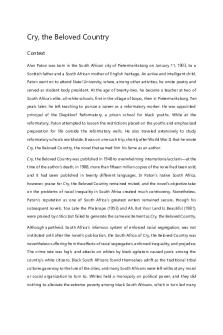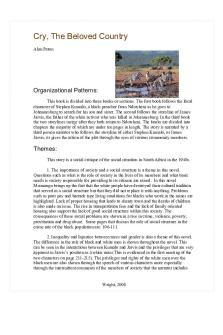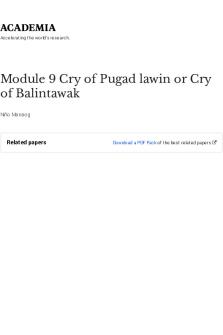Cry, the Beloved Country Cry - Diary PDF

| Title | Cry, the Beloved Country Cry - Diary |
|---|---|
| Course | StuDocu Summary Library EN |
| Institution | StuDocu University |
| Pages | 12 |
| File Size | 153.1 KB |
| File Type | |
| Total Downloads | 53 |
| Total Views | 130 |
Summary
Cry, the Beloved Country...
Description
Cry, the Beloved Country Context Alan Paton was born in the South African city of Pietermaritzburg on January 11, 1903, to a Scottish father and a South African mother of English heritage. An active and intelligent child, Paton went on to attend Natal University, where, among other activities, he wrote poetry and served as student body president. At the age of twenty-two, he became a teacher at two of South Africa’s elite, all-white schools, first in the village of Ixopo, then in Pietermaritzburg. Ten years later, he left teaching to pursue a career as a reformatory worker. He was appointed principal of the Diepkloof Reformatory, a prison school for black youths. While at the reformatory, Paton attempted to loosen the restrictions placed on the youths and emphasized preparation for life outside the reformatory walls. He also traveled extensively to study reformatory schools worldwide. It was on one such trip, shortly after World War II, that he wrote Cry, the Beloved Country, the novel that earned him his fame as an author. Cry, the Beloved Country was published in 1948 to overwhelming international acclaim—at the time of the author’s death, in 1988, more than fifteen million copies of the novel had been sold, and it had been published in twenty different languages. In Paton’s native South Africa, however, praise for Cry, the Beloved Country remained muted, and the novel’s objective take on the problems of racial inequality in South Africa created much controversy. Nonetheless, Paton’s reputation as one of South Africa’s greatest writers remained secure, though his subsequent novels, Too Late the Phalarope (1953) and Ah, But Your Land Is Beautiful (1981), were praised by critics but failed to generate the same excitement as Cry, the Beloved Country. Although apartheid, South Africa’s infamous system of enforced racial segregation, was not instituted until after the novel’s publication, the South Africa of Cry, the Beloved Country was nevertheless suffering from the effects of racial segregation, enforced inequality, and prejudice. The crime rate was high, and attacks on whites by black agitators caused panic among the country’s white citizens. Black South Africans found themselves adrift as the traditional tribal cultures gave way to the lure of the cities, and many South Africans were left without any moral or social organization to turn to. Whites held a monopoly on political power, and they did nothing to alleviate the extreme poverty among black South Africans, which in turn led many
young black men to crime. The gold mines, which were so vital to South Africa’s economy, depended on cheap black labor to remain profitable, and as a result, the workers were paid barely enough to survive. But those in power inevitably broke up attempts to strike or seek a better wage. Cry, the Beloved Country is set in this tense and fragile society, where the breathtaking beauty of the nation’s natural landscape is tainted by the fears of its people. And yet, the message of the novel is one of hope. Characters such as Stephen Kumalo, James Jarvis, and Theophilus Msimangu reveal a potential for goodness in humankind, and are able to defuse hatred, overcome fear, and take the first steps necessary for mending a broken nation.
Historical Background Cry, the Beloved Country is set in South Africa in the 1940s. Its story unfolds against a backdrop of economic and political tensions that have a lengthy, complicated history. Thousands of years before the first Europeans arrived, southern Africa was populated by various African tribal groups, including the San, the Khoikhoi, and, later on, Bantu-speaking peoples who were ancestors of the modern Zulus. The first European settlers in South Africa, the Dutch, arrived in the mid-1600s. The Dutch wanted only to set up bases for trade, not to colonize the country, and they met with little resistance. But by the mid-1700s, the Dutch, who had come to be known as the Boers and who had developed their own language, Afrikaans, had begun to settle deeper and deeper into the country. In a process similar to the displacement and destruction of Native American life in the United States, African tribes were forced off their traditional lands, decimated by disease, and defeated in battles against the well-armed Boers. English settlers first arrived in 1795. Unlike the Dutch, by the early 1800s the English decided to make South Africa a full-fledged colony. Concentrated in coastal cities, the English soon found themselves in conflict with Boer farmers, who called themselves “the white tribe of Africa.” The Boers moved north, away from the coast, while the Zulus, led by the famous warrior-leader Shaka, pressed south on a military campaign. Inevitably, the two groups clashed, fighting a number of bloody battles before the Zulus were defeated. The Boers created several independent republics, but when diamonds and gold were discovered in the Boer territories, the British moved to annex them, leading to the first Anglo-Boer war in 1881. The Boers regained the independence of their territories, but when gold was discovered near what is now
Johannesburg in 1886, the British invaded the area again. The second Anglo-Boer war lasted from 1899 to 1902. The victorious British were able to establish rule, and they officially established the Union of South Africa in 1910. Cry, the Beloved Country takes place after these upheavals and immediately before the implementation, in 1948, of apartheid, which codified the systematic inequalities depicted in the novel. During the time in which the novel is set, black workers were permitted to hold only unskilled jobs and were subject to “pass laws” that restricted their freedom of movement. In 1913, the Natives Land Act radically limited the amount of land that black South Africans were permitted to own. As the character Arthur Jarvis states in the novel, just one-tenth of the land was set aside for four-fifths of the country’s people. The resultant overcrowding led many black South Africans to migrate to Johannesburg to work in the mines. Those in power welcomed the influx of cheap labor but failed to provide adequate housing or services to address the mass migration. These are the circumstances under which the character Stephen Kumalo leaves his impoverished rural village to search for his son in Johannesburg. Though Paton’s novel helped raise the social consciousness of white South Africa, things got much worse before they got better. In 1948, the National Party (representing Afrikaner and conservative interests) gained power and introduced apartheid. Under apartheid, every South African was classified according to race, and the Group Areas Act enforced the physical separation of blacks from whites. Every aspect of South African life was racially segregated. Under the leadership of Nelson Mandela, the African National Congress (ANC), which had been founded in 1912 as the South African Native National Congress and renamed in 1923, began protests against the new laws in the form of strikes and marches. After decades of struggle and bloodshed, the ANC prevailed, and South Africa held its first free election in 1994. Mandela was elected president, apartheid was dismantled, and the country ratified one of the most liberal constitutions in the world.
Plot Overview In the remote village of Ndotsheni, in the Natal province of eastern South Africa, the Reverend Stephen Kumalo receives a letter from a fellow minister summoning him to Johannesburg, a city in South Africa. He is needed there, the letter says, to help his sister, Gertrude, who the letter says has fallen ill. Kumalo undertakes the difficult and expensive journey to the city in the
hopes of aiding Gertrude and of finding his son, Absalom, who traveled to Johannesburg from Ndotsheni and never returned. In Johannesburg, Kumalo is warmly welcomed by Msimangu, the priest who sent him the letter, and given comfortable lodging by Mrs. Lithebe, a Christian woman who feels that helping others is her duty. Kumalo visits Gertrude, who is now a prostitute and liquor-seller, and persuades her to come back to Ndotsheni with her young son. A more difficult quest follows when Kumalo and Msimangu begin searching the labyrinthine metropolis of Johannesburg for Absalom. They visit Kumalo’s brother, John, who has become a successful businessman and politician, and he directs them to the factory where his son and Absalom once worked together. One clue leads to another, and as Kumalo travels from place to place, he begins to see the gaping racial and economic divisions that are threatening to split his country. Eventually, Kumalo discovers that his son has spent time in a reformatory and that he has gotten a girl pregnant. Meanwhile, the newspapers announce that Arthur Jarvis, a prominent white crusader for racial justice, has been murdered in his home by a gang of burglars. Kumalo and Msimangu learn that the police are looking for Absalom, and Kumalo’s worst suspicions are confirmed when Absalom is arrested for Jarvis’s murder. Absalom has confessed to the crime, but he claims that two others, including John Kumalo’s son, Matthew, aided him and that he did not intend to murder Jarvis. With the help of friends, Kumalo obtains a lawyer for Absalom and attempts to understand what his son has become. John, however, makes arrangements for his own son’s defense, even though this split will worsen Absalom’s case. When Kumalo tells Absalom’s pregnant girlfriend what has happened, she is saddened by the news, but she joyfully agrees to his proposal that she marry his son and return to Ndotsheni as Kumalo’s daughter-in-law. Meanwhile, in the hills above Ndotsheni, Arthur Jarvis’s father, James Jarvis, tends his bountiful land and hopes for rain. The local police bring him news of his son’s death, and he leaves immediately for Johannesburg with his wife. In an attempt to come to terms with what has happened, Jarvis reads his son’s articles and speeches on social inequality and begins a radical reconsideration of his own prejudices. He and Kumalo meet for the first time by accident, and after Kumalo has recovered from his shock, he expresses sadness and regret for Jarvis’s loss. Both men attend Absalom’s trial, a fairly straightforward process that ends with the death penalty for Absalom and an acquittal for his co-conspirators. Kumalo arranges for Absalom to marry the girl who bears his child, and they bid farewell. The morning of his departure, Kumalo
rouses his new family to bring them back to Ndotsheni only to find that Gertrude has disappeared. Kumalo is now deeply aware of how his people have lost the tribal structure that once held them together, and he returns to his village troubled by the situation. It turns out that James Jarvis has been having similar thoughts. Arthur Jarvis’s young son befriends Kumalo, and as the young boy and the old man become acquainted, James Jarvis becomes increasingly involved with helping the struggling village. He donates milk at first, then makes plans for a dam and hires an agricultural expert to demonstrate newer, less devastating farming techniques. When Jarvis’s wife dies, Kumalo and his congregation send a wreath to express their sympathy. Just as the diocese’s bishop is on the verge of transferring Kumalo, Jarvis sends a note of thanks for the wreath and offers to build the congregation a new church, and Kumalo is permitted to stay in his parish. On the evening before his son’s execution, Kumalo goes into the mountains to await the appointed time in solitude. On the way, he encounters Jarvis, and the two men speak of the village, of lost sons, and of Jarvis’s bright young grandson, whose innocence and honesty have impressed both men. When Kumalo is alone, he weeps for his son’s death and clasps his hands in prayer as dawn breaks over the valley.
Character List Stephen Kumalo - One of the novel’s two protagonists. Kumalo is an elderly Zulu priest who has spent all of his life in the village of Ndotsheni. He is a quiet, humble, and gentle man with a strong moral sense and an abiding faith in God. He is not perfect, however, and occasionally gives in to the temptation to hurt others with harsh words or lies. The dignity and grace with which he accepts his suffering, however, along with his determination to help his people in spite of his limitations, make him the moral center of the novel. James Jarvis - The novel’s other protagonist, a white landowner whose farm overlooks Ndotsheni. When he first appears in the novel, Jarvis is a relatively conservative farmer and a man of few words. But the tragic news that his only son, Arthur, has been murdered leads him to Johannesburg, where he begins to rethink his opinions and his relationship to the villagers that live below his farm.
Theophilus Msimangu - Stephen Kumalo’s host and guide in Johannesburg. A tall, young minister at the Mission House in Sophiatown, Msimangu has an acute understanding of the problems that face South Africa. He helps Kumalo understand the people and places that they encounter, and is unfailingly sympathetic to Kumalo, making Kumalo’s quest his top priority. He sometimes speaks unkindly, but he quickly repents. His eventual decision to enter a monastery is a final testament to the depth of his faith and generosity. Absalom Kumalo - Stephen Kumalo’s son. After fleeing home for Johannesburg, Absalom quickly goes astray, but even after he commits murder, he is able to reclaim his fundamental decency. His decision to move to Johannesburg is part of a larger trend of young black people fleeing their villages for the cities. Absalom’s story is a cautionary tale of the dangers of this movement. Seeming to lack a reliable moral compass, he is influenced by bad companions and begins a criminal career. John Kumalo - Stephen Kumalo’s brother. Formerly a humble carpenter and a practicing Christian, John Kumalo becomes a successful businessman and one of the three most powerful black politicians in Johannesburg. He has a beautiful and powerful voice, which he uses to speak out for the rights of black South Africans, but his fear of punishment prevents him from pushing for actual radical change, and he is considered by many to be without courage. Arthur Jarvis - Arthur Jarvis’s name first appears in the novel after he has been murdered, but he is a powerful presence whose legacy hovers over the whole novel. An engineer and fierce advocate for justice for black South Africans, he is shot dead in his home by Absalom Kumalo. Mrs. Kumalo - Stephen Kumalo’s strong-minded, supportive, and loving wife. Mrs. Kumalo and her husband make household decisions as equals, and she bears hardship gracefully. When Kumalo is inclined to brood, she rouses him to action, and it is she who supplies the courage needed to read the bad news that the mail brings from Johannesburg. Gertrude Kumalo -
Stephen Kumalo’s sister and the original reason for his trip to
Johannesburg. Gertrude, twenty-five years younger than Kumalo and living in Johannesburg, is easily influenced. When Kumalo reminds her of her Christian duties and obligations, she attempts to return to them, but she lacks real determination. Gertrude’s son - Kumalo’s nephew. He brings comfort to Kumalo during his troubles. He returns with Kumalo to Ndotsheni, where Absalom’s wife raises him.
Mrs. Lithebe - The woman with whom Kumalo stays in Johannesburg. Mrs. Lithebe is an Msutu woman who lives in Sophiatown and takes in boarders, especially priests. She is a good and generous Christian who believes that helping others is simply her duty. The young man - A young white man who works at the reformatory and attempts to reform Absalom. Although he does, on one occasion, chastise Kumalo, he does so because he cares much for his pupils, and the thought of Absalom’s predicament pains him. Father Vincent - An Anglican priest from England who stays at the Sophiatown Mission and offers to help Kumalo with his troubles. Father Vincent counsels Kumalo when he is brokenhearted over his son and presides over the wedding between Absalom and Absalom’s girlfriend. He is warm and understanding, and he possesses deep faith. Absalom’s girlfriend - The kindhearted and quiet sixteen-year-old girl whom Absalom has impregnated. She has run away from her dysfunctional family but still seeks a family structure and bonds. She is sexually experienced but essentially innocent, obedient, and grateful for adult protection. Margaret Jarvis - James Jarvis’s wife. Margaret takes the death of her son very hard. She is a physically fragile and loving woman who commiserates with and supports her husband through their grief. She also shares in his plans to help Ndotsheni. John Harrison - The brother of Mary Jarvis, Arthur Jarvis’s wife. John is young and quickwitted, and shares Arthur’s opinions about the rights of the black population in South Africa. He provides companionship to James Jarvis in Johannesburg. Mr. Harrison - Mary Jarvis’s father. Mr. Harrison has conservative political views and blames black South Africans for the country’s problems. Though he disagrees with Arthur, he admires Arthur’s courage. Arthur’s son - Although only a child, Arthur’s son is very much like his father. He is curious, intelligent, and generous. He treats black people with unusual courtesy and pleases Kumalo by visiting him and practicing Zulu. Napoleon Letsitsi - The agricultural expert hired by James Jarvis to teach better farming techniques to the people of Ndotsheni. A well-educated middle-class black man, Letsitsi earns a good salary and is eager to help build his country. Although grateful for the help of good
white men, he nonetheless looks forward to an Africa in which black people will not rely on whites for their basic needs. Matthew Kumalo - John Kumalo’s son. We learn little about Matthew, but he is important to the plot of the novel, as he is a good friend and eventual accomplice of Absalom’s. Eventually, however, Matthew denies having been present at the robbery, turning his back on his cousin and friend. Johannes Pafuri - The third young man present at the attempted robbery of Arthur Jarvis’s house. According to Absalom’s testimony, Pafuri is the ringleader of the group, deciding the time of the robbery and having his weapon “blessed” to give them good luck. Mr. Carmichael - An acquaintance of Father Vincent’s who becomes Absalom’s lawyer. Mr. Carmichael is a tall and serious man who carries himself with an almost royal bearing. He takes Absalom’s case pro deo (“for God”). The Judge - The judge who presides over Absalom’s case seems to be a fair-minded man, but he is constrained by unjust laws and applies them strictly. Dubula - The second in a trio of powerful black politicians in Johannesburg. Dubula provides the heart to complement John Kumalo’s voice. The bus boycott and the construction of Shanty Town are his handiwork. Tomlinson - The third colleague of Dubula and John Kumalo. While not a great orator, Tomlinson is considered the smartest of the three. Mary Jarvis - Arthur Jarvis’s wife. Mary takes her husband’s murder hard, but she remains strong for her children. She shares her husband’s commitment to justice.
Themes, Motifs & Symbols Themes RECONCILIATION BETWEEN FATHERS AND SONS Cry, the Beloved Country chronicles the searches of two fathers for their sons. For Kumalo, the search begins as a physical one, and he spends a number of days combing Johannesburg in search of Absalom. Although most of his stops yield only the faintest clues as to Absalom’s
whereabouts, the clues present a constantly evolving picture of who Absalom has become. As Kumalo knocks on the doors of Johannesburg’s slums, he hears of his son’s change from factory worker to burglar, then from promising reformatory pupil to killer. When Kumalo and Absalom are finally reunited after Absalom’s incarceration, they are virtual strangers to each other. The ordeal of the trial brings them closer together, but it is not until after the guilty verdict that Kumalo begins to understand Absalom. In Absalom’s letters from prison, Kumalo finds evidence of true repentance and familiar flashes of the little boy he remembers. Jarvis has no actual searching to do, but it takes him l...
Similar Free PDFs

Cry, the Beloved Country Cry - Diary
- 12 Pages

Cry, the Beloved Country - Diary
- 7 Pages

Cry, the Beloved Country Essay
- 3 Pages

The no Cry Sleep Solution.pdf
- 273 Pages

CRY-of-Rebellion - nnnkjnjnknn
- 2 Pages

The Language You Cry In
- 2 Pages

Cry freedom summary
- 1 Pages

Ruel - Don\'t Cry - fbffbffffgfg
- 1 Pages

Never cry wolf analysis
- 4 Pages

Summary-Cry of Rebellion
- 3 Pages

I Cry - Tupac Poem Analyst
- 3 Pages
Popular Institutions
- Tinajero National High School - Annex
- Politeknik Caltex Riau
- Yokohama City University
- SGT University
- University of Al-Qadisiyah
- Divine Word College of Vigan
- Techniek College Rotterdam
- Universidade de Santiago
- Universiti Teknologi MARA Cawangan Johor Kampus Pasir Gudang
- Poltekkes Kemenkes Yogyakarta
- Baguio City National High School
- Colegio san marcos
- preparatoria uno
- Centro de Bachillerato Tecnológico Industrial y de Servicios No. 107
- Dalian Maritime University
- Quang Trung Secondary School
- Colegio Tecnológico en Informática
- Corporación Regional de Educación Superior
- Grupo CEDVA
- Dar Al Uloom University
- Centro de Estudios Preuniversitarios de la Universidad Nacional de Ingeniería
- 上智大学
- Aakash International School, Nuna Majara
- San Felipe Neri Catholic School
- Kang Chiao International School - New Taipei City
- Misamis Occidental National High School
- Institución Educativa Escuela Normal Juan Ladrilleros
- Kolehiyo ng Pantukan
- Batanes State College
- Instituto Continental
- Sekolah Menengah Kejuruan Kesehatan Kaltara (Tarakan)
- Colegio de La Inmaculada Concepcion - Cebu




